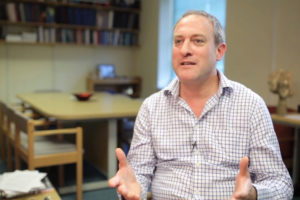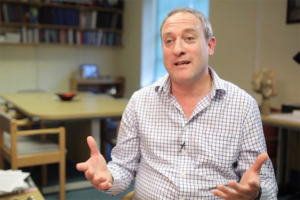Engineering More Effective Antibiotics
Boston University Prof. James Collins on bacterial resistance, active mutagens, and efficacy of biocides
Why do we need to measure magnetic fields? What are the new non-invasive measurement tools? How can we take advantage of quantum mechanical properties of a nitrogen atom? These and other questions are answered by Senior Lecturer at Harvard University Ronald Walsworth.
Measuring magnetic fields that come from living organisms – it has been of great interest for a long time, because there are properties of magnetic fields that are particularly useful for understanding biology, and in medicine as well. And one of the main properties is that magnetic fields pass through matter easily without being perturbed or absorbed very much. If you try to go in and measure things optically, if you try to go in and do a normal microscopy with optics, you can go in in infrared a millimeter, or two, or three, but you can’t go deep inside things. And magnetic fields pass out of bodies or organisms very easily. There are variety of interesting phenomena which make magnetic fields or sources of magnetic fields. Most prominently is an MRI, magnetic resonance imaging, where the magnetic fields come from the nuclei, the protons and other nuclei within the molecules within bodies.
But there are other sources of magnetic fields. There are currents which are firing in brains, and our nerve cells create magnetic fields. People who have ever had MEG – network of magnetic sensors around heads, are looking that sort of thing, but it’s also interesting in the biological level. And there are localized nanoscale sources of magnetic fields, which are very important, where we have clusters of often iron containing compounds. They are found naturally and normally in various types of simple organisms and more advanced organisms. We have them, humans have them in our bodies as do a variety of organisms.
So there are a lot of reasons why people are interested in being able to measure magnetic fields that come from living organisms. One of the challenges is that magnetic fields, a flip side of them not being absorbed in passing through things,is that they are weak and hard to detect. Something like conventional MRI is able to detect magnetic fields inn to about 1mm3 or a little bit smaller. That sounds like a small size, it is compared to our human body, but if you are looking at one individual cell – it’s much larger than one individual cell. We have thousands of cells in such a small volume, or millions, depending on the size of cells. And if you want to look at structures within cells – you want to look at the cell nucleus or cell walls, or ribosomes, or mitochondria, other kind of processes that are going on inside of cells – forget it. Conventional MRI of that type that we see in hospitals, etc. can come nowhere close to doing the job.
So people have been interested, myself included, in developing new measurement tools which can non-invasively probe and measure magnetic fields in living organisms, living cells, down in very small scales, down to the single cell size, which is usually a few microns, and below that – micron is a millionth of a meter – down inside, well inside the cell, down to the nanoscale – billionths of meter.
And so my colleagues and I have developed a technology, which looks very promising for this sort of application. And it involves, again, understanding the basic quantum physics of atoms. In this case, nitrogen atoms and a missing carbon atom frozen into a diamond lattice – that’s our type of magnetic sensors that we use. This nitrogen and a missing carbon atom in a diamond lattice – that missing carbon atom is sometimes called a “vacancy” – and so you call this a nitrogen-vacancy or, for shorthand, N-V color center in diamond.
These N-V color centers in diamond exist in high density are what gives diamond naturally a pink color. So they are naturally occurring phenomena in diamonds, although we can manufacture diamonds to have these particular defects in them. This could be a bulk diamond, the sort out of which you can make a gemstone, or it could be very small specially crafted nanodiamonds. Nanodiamonds that are more spherical or that are pillars etc. designed to be able to go into cells or go near the cells and have this N-V center, which has very special properties to be able to be used as your magnetic field probe.
Its special properties are quantum mechanical properties. It gives off, it absorbs green light and emits red light. And the red light that it emits in the NV center is a strong function of the local magnetic field that it has. In fact, it has quantum mechanical energy levels, associated with it are a spin, or a permanent angular momentum which are sensitive to magnetic fields, so the rate at which this spin or the magnetic moment of the NV rotates is a function of the local magnetic fields.
Let’s say, you had a diamond chip, and you had one of these N-V centers near the surface, or several of them. It’s going to absorb green light and emit red light as a strong function of the local magnetic field, as I said. Let’s say that N-V center is just a few nanometers below the surface of the diamond chip. We can plug on top of it a series of living cells – it could be living tissue, it could be individual cells such as bacteria, etc. If those cells are giving off magnetic fields, these N-V centers are probe right up next to it and can be a little sensor. It’s localized, it’s just an angstrom or two in size, which is a tenth of a nanometer, so it is a very local source to measure the magnetic fields. And, since it emits light, we can image the magnetic fields at that nanoscale by measuring the light.
What we’ve been able to do is to take diamond chips with many N-V centers in the surface layer, have a population of living cells on top creating magnetic fields in a variety of interesting ways and then image those magnetic fields on the camera like a CCD ray or a CMOS ray using conventional optics. It works very well: the green light we use to be absorbed by the N-V centers can be injected in a way that does not get into the cells and doesn’t harm them. So it’s a very non-invasive, widely applicable tool for measuring magnetic fields.
You can synthesize, instead of just bulk diamond chips, little diamond probes, little nanoparticles which can go into cells.
They can live inside of cells and be targeted with the surface functionalization to go at the particular part of the cell that you are interested in. Perhaps you are interested in, again, something like a mitochondria, were there is some respiration going on, or the cell wall, or the cell nucleus, or other sorts of structures. These nanoparticles can be functionalized to target those places. You can go in with a green light, rid of the red light which can be a measure of the local magnetic field inside.
Then these centers also have the ability to measure temperature locally and electric fields locally. So they are a wonderful little quantum probe, taking advantage of the quantum mechanical properties of a nitrogen atom and a missing carbon atom right next to each other to be able to measure magnetic fields, electric fields and temperature in living organisms.
A specific example of something we’ve done fairly recently, it’s probably just the first stage in many things that can be possible, is to take a type of bacteria known as magnetotactic bacteria. These are ancient organisms, ancient in a sense that they are believed to have evolved about two billion years ago. They’re prokaryotes, which means they don’t even have a cell nucleus, they are kinds of bacteria. And amazingly they naturally synthesize magnetic nanoparticles, each about fifty nanometers in size, one after another, they are like little magnets, and they are able to line a whole series of them, maybe ten, twenty, thirty of them up inside their bodies along a chain, a filament, a protein, like a compass needle. So there is a series of these, they form a compass needle inside the bacteria which is only about two microns long. The bacterium has a flagellum, it swims, and this compass needle helps navigate the bacterium to want to go down in ponds. There are many species of these types of bacteria, they are very common around the world. There’s a pond nearby here our lab in Cambridge, Massachusetts, where we can find them. And they like going down, where the oxygen level is low, because they are anaerobes, they try to go into environments with low oxygen.
In the northern hemisphere they synthesize the magnetic axis aligned opposite of the southern hemisphere so they can navigate properly in these two hemispheres – amazing things! They can synthesize magnetic nanoparticles more perfectly than we, humans, can in our nanosynthesis, at least to date. How are they able to do this? What are the genes that control this sort of thing? How perfectly aligned are they? To date people could look at them in electron microscopes, find these nanoparticles, but they couldn’t take the living bacteria and study them with high enough resolution before our work to see inside the cells and see the magnetic field patterns inside.
The genes, it turns out, control this synthesis and some of the behavior of the nanoparticles inside these magnetotactic bacteria. Some of the same genes are found in higher organisms like humans and other kinds of high organisms. Do they play a role in regulating the use of iron in our body in some way – that’s maybe not about us having compass needles and navigating, maybe they do for things likepassenger pigeons and what not, but maybe they are relevant to other things that go on in our bodies in terms of cell behavior even when they go awry in terms of disease.
Many open questions, but we couldn’t begin to address these magnetic properties of these species until we had the measurement tools to be able to see inside them non-invasively while they are alive. And these quantum defects known as these nitrogen vacancies or the N-V color centers in a diamond is one way to do that, it’s a nice example of how pushing measurement technologies has opened up a new window in being able to see a little inside living organisms.
We hope in the future, the community hopes in the future to be able to apply this sort of technology to a wide range of studies of both simple bacteria and more complicated cells. Perhaps we’ll be able to look at firing neurons, networks of brain cells, be able to see the magnetic field patterns that come from them both in simple neuronal circuits placed onto a diamond chip, and eventually with quantum diamond probes going into brains to be able to understand how brains operate well.
So there is a lot of opportunities being able to push the ability to measure things very well down to the nanoscale taking advantage of quantum physics, such as being able to measure magnetic fields that come from many sources in living cells. And that’s what we are working on.
Currently, one of the challenges of this sort of technology, of these quantum defects in diamond is that in the plainer diamond chips with the N-V centers at the surface we can measure magnetic fields, or electric fields, or temperature very well in the two-dimensional system that sits right on the surface. And I’ve mentioned how we can fabricate nanoparticles of various shapes to go into cells. But that does not help us get the light back out from these emitters if they are deep inside of cells. So we still have the same sort of limitations that you’d have of any kind of optical microscopy in the third dimension that is trying to get the light out more than, let’s say, a millimeter. So if you wanted a true microscopic organism – not just human brains, you don’t have to be that big, or human bodies – but anything that’s beyond about a millimeter in size in that third dimension – there is a 2D plain, we’re going up in the third dimension. Since the signal from these defects comes out as light, as optical light, it will be absorbed and scattered by tissue that’s in the way.
So one of the challenges is to figure out a way to bring that information out. It may involve, instead of just nanodiamonds, which are spherical type things or sort of like boulders, constructed to be more like very narrow needles in which the sensors would be at the tip, and then you could pierce in like a needle into the probe. That’s still somewhat invasive because it involves probing in, but that’s one of our challenges.
Another challenge is to be able to have true subnanometer scale.
We want to get down to the angstrom scale being able to measure individual spins – electronic and nuclear spins inside of molecules.
Let’s say, going well below living cells, we want to look at individual biomolecules. We want to map one atom at a time in DNA or something like this, or some sort of other biomolecule.
That may be possible with this technology, but it’s going to require being able to put the nitrogen vacancy centers very close to the surface of the diamond and not corrupt their properties. Why? Because the magnetic fields that come from the source, like from the spinning nuclei within a molecule, the strengths of those fields fall off rapidly as you move away, they really fall off as one over the separation cubed. So the closer you get, the stronger the fields are. If you have this N-V center deep inside the diamond, and here is your thing to be studied, it’s far enough away that the fields are very weak and can’t be studied.
So the real challenge is to learn how to place, whether it being in bulk diamonds or in nanodiamonds, these little sensors within one nanometer or less of the surface without corrupting their behavior. So you have to get really close to be able to sense things.

Boston University Prof. James Collins on bacterial resistance, active mutagens, and efficacy of biocides

Neuroscientist Neil Burgess on the difference between short-term and long-term memory, phonological loop, and ...

Neuroscientist Neil Burgess on different types of memory, the H.M. patient case, and the role of hippocampus i...